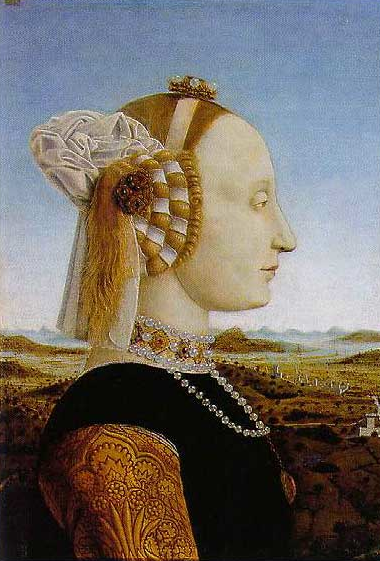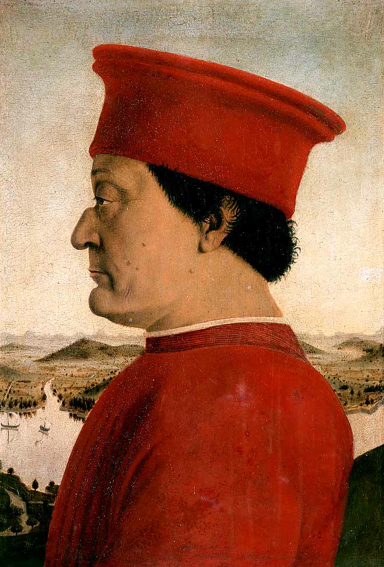Piero della Francesca - Diptych of the Duchess and the Duke of Urbino


The famous Urbino Diptych, painted on both sides, probably joined by a hinge to be opened like a book, was originally in the Audience Hall of Palazzo Ducale. It arrived in Florence in 1631 as part of the inheritance of Vittoria della Rovere, wife of the Grand Duke Ferdinand II.
On the front are the Duke and the Duchess facing one another in solemn profile as on a classical medallion. The precision of the features, focusing even on less attractive details (such as Federigo’s unforgettable nose, broken during a tournament), is typical of Flemish art and confirms that Piero della Francesca, active at the court of Urbino, was one of the most sensitive interpreters of Nordic art, well-known and appreciated at that time from Ferrara to Florence, from Urbino to Southern Italy. Even the crystal-clear landscape in the background, fading towards the distant hills and the horizon, possibly evoking the territory of Motefeltro, the Duke’s land, is treated with an almost miniaturist technique. Without the traditional expedient of a curtain or window, the magnificent bird’s-eye view unites the perspective of the two panels. The two scenes on the back with allegorical chariots, whose figurative fortune in humanistic times derived from Petrarch’s 14th century poetic Triumphes, symbolize the moral values of the two personages. Each of them is solemnly accompanied on the chariot by four virtues: the theological ones (Faith, Charity, Hope and Modesty) for Battista Sforza, and the cardinal virtues (Prudence, Temperance, Fortitude and Justice) for Federigo. The chariot of Battista, intent on reading a book of prayer, is drawn by two unicorns, symbol of purity and marital fidelity, their reins held by a little angel. The landscape in the background may be that of the Valdichiana (near Arezzo). On the other panel a winged Victory crowns Federigo. The lake in the background has been identified with Trasimeno. According to recent hypotheses, the two paintings on the back at least were painted later than the customarily accepted date of 1460-1465, after the death in childbirth of Battista, whose son Guidubaldo, the anxiously awaited heir, was born in July 1472. This seems to be indicated by the inscription in Latin, in beautiful Sapphic verses, on the classical style marble below her image “She who was able to retain moderation in favorable times flies on the mouths of all men, adorned by the praise of her great husband’s undertakings”. Below Federigo’s triumphal chariot is written: “He who the undying fame of the virtues proclaims worthy to hold the scelte, peer of the greatest condottieri, the illustrious one is carried in grandiose triumph”.









